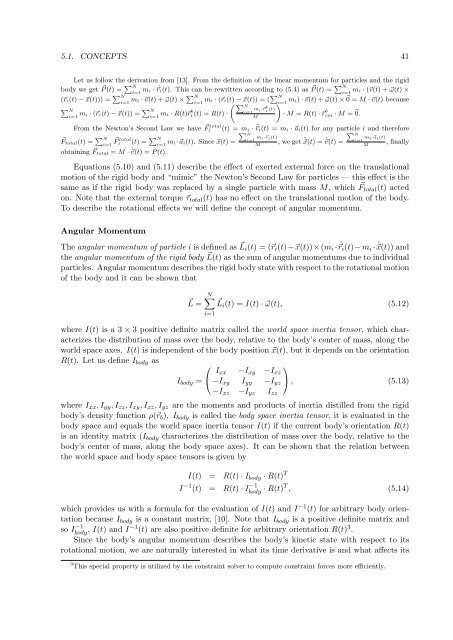thesis - Computer Graphics Group - Charles University - Univerzita ...
thesis - Computer Graphics Group - Charles University - Univerzita ...
thesis - Computer Graphics Group - Charles University - Univerzita ...
Create successful ePaper yourself
Turn your PDF publications into a flip-book with our unique Google optimized e-Paper software.
5.1. CONCEPTS 41<br />
Let us follow the derivation from [13]. From the definition of the linear momentum for particles and the rigid<br />
body we get P (t) = N mi · ri(t). ˙ This can be rewritten according to (5.4) as i=1 P (t) = N mi · (v(t) + ω(t) ×<br />
i=1<br />
(ri(t) − x(t))) = N i=1 mi · v(t) + ω(t) × N i=1 mi · (ri(t) − x(t)) = ( N<br />
i=1 mi) · v(t) + ω(t) × 0 = M · v(t) because<br />
N i=1 mi · (ri(t) − x(t)) = N i=1 mi · R(t)rb N i=1<br />
i (t) = R(t) ·<br />
mi·r b i (t)<br />
<br />
· M = R(t) · r M<br />
b cm · M = 0.<br />
(t) = mi · ¨ ri(t) = mi · ai(t) for any particle i and therefore<br />
Ftotal(t) = N i=1 F total<br />
i (t) = N N<br />
i=1<br />
mi ·ai(t). Since x(t) =<br />
i=1 mi·r i(t)<br />
, we get M<br />
¨ x(t) = ˙ N i=1 v(t) =<br />
mi·a i(t)<br />
, finally<br />
M<br />
obtaining Ftotal = M · ˙ v(t) = ˙ P (t).<br />
From the Newton’s Second Law we have F total<br />
i<br />
Equations (5.10) and (5.11) describe the effect of exerted external force on the translational<br />
motion of the rigid body and “mimic” the Newton’s Second Law for particles — this effect is the<br />
same as if the rigid body was replaced by a single particle with mass M, which Ftotal(t) acted<br />
on. Note that the external torque τtotal(t) has no effect on the translational motion of the body.<br />
To describe the rotational effects we will define the concept of angular momentum.<br />
Angular Momentum<br />
The angular momentum of particle i is defined as Li(t) = (ri(t)−x(t))×(mi · ˙<br />
ri(t)−mi · ˙ x(t)) and<br />
the angular momentum of the rigid body L(t) as the sum of angular momentums due to individual<br />
particles. Angular momentum describes the rigid body state with respect to the rotational motion<br />
of the body and it can be shown that<br />
L =<br />
N<br />
Li(t) = I(t) · ω(t), (5.12)<br />
i=1<br />
where I(t) is a 3 × 3 positive definite matrix called the world space inertia tensor, which characterizes<br />
the distribution of mass over the body, relative to the body’s center of mass, along the<br />
world space axes. I(t) is independent of the body position x(t), but it depends on the orientation<br />
R(t). Let us define Ibody as<br />
⎛<br />
⎞<br />
Ibody = ⎝<br />
Ixx −Ixy −Ixz<br />
−Ixy Iyy −Iyz<br />
−Ixz −Iyz Izz<br />
⎠ , (5.13)<br />
where Ixx, Iyy, Izz, Ixy, Ixz, Iyz are the moments and products of inertia distilled from the rigid<br />
body’s density function ρ(rb). Ibody is called the body space inertia tensor, it is evaluated in the<br />
body space and equals the world space inertia tensor I(t) if the current body’s orientation R(t)<br />
is an identity matrix (Ibody characterizes the distribution of mass over the body, relative to the<br />
body’s center of mass, along the body space axes). It can be shown that the relation between<br />
the world space and body space tensors is given by<br />
I(t) = R(t) · Ibody · R(t) T<br />
I −1 (t) = R(t) · I −1<br />
body · R(t)T , (5.14)<br />
which provides us with a formula for the evaluation of I(t) and I −1 (t) for arbitrary body orientation<br />
because Ibody is a constant matrix, [10]. Note that Ibody is a positive definite matrix and<br />
so I −1<br />
body , I(t) and I−1 (t) are also positive definite for arbitrary orientation R(t) 3 .<br />
Since the body’s angular momentum describes the body’s kinetic state with respect to its<br />
rotational motion, we are naturally interested in what its time derivative is and what affects its<br />
3 This special property is utilized by the constraint solver to compute constraint forces more efficiently.
















